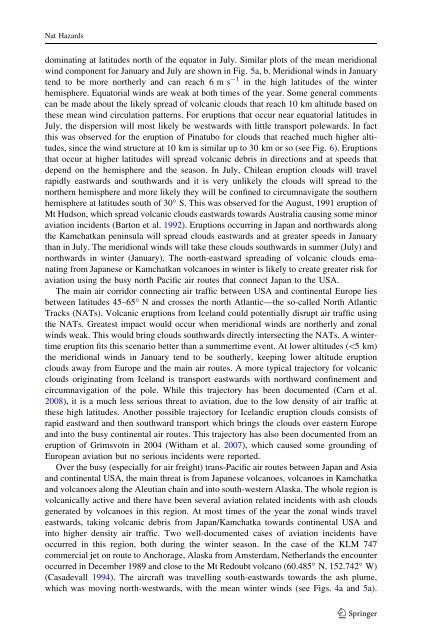Satellite detection of hazardous volcanic clouds and ... - Savaa - NILU
Satellite detection of hazardous volcanic clouds and ... - Savaa - NILU
Satellite detection of hazardous volcanic clouds and ... - Savaa - NILU
You also want an ePaper? Increase the reach of your titles
YUMPU automatically turns print PDFs into web optimized ePapers that Google loves.
Nat Hazardsdominating at latitudes north <strong>of</strong> the equator in July. Similar plots <strong>of</strong> the mean meridionalwind component for January <strong>and</strong> July are shown in Fig. 5a, b. Meridional winds in Januarytend to be more northerly <strong>and</strong> can reach 6 m s -1 in the high latitudes <strong>of</strong> the winterhemisphere. Equatorial winds are weak at both times <strong>of</strong> the year. Some general commentscan be made about the likely spread <strong>of</strong> <strong>volcanic</strong> <strong>clouds</strong> that reach 10 km altitude based onthese mean wind circulation patterns. For eruptions that occur near equatorial latitudes inJuly, the dispersion will most likely be westwards with little transport polewards. In factthis was observed for the eruption <strong>of</strong> Pinatubo for <strong>clouds</strong> that reached much higher altitudes,since the wind structure at 10 km is similar up to 30 km or so (see Fig. 6). Eruptionsthat occur at higher latitudes will spread <strong>volcanic</strong> debris in directions <strong>and</strong> at speeds thatdepend on the hemisphere <strong>and</strong> the season. In July, Chilean eruption <strong>clouds</strong> will travelrapidly eastwards <strong>and</strong> southwards <strong>and</strong> it is very unlikely the <strong>clouds</strong> will spread to thenorthern hemisphere <strong>and</strong> more likely they will be confined to circumnavigate the southernhemisphere at latitudes south <strong>of</strong> 30° S. This was observed for the August, 1991 eruption <strong>of</strong>Mt Hudson, which spread <strong>volcanic</strong> <strong>clouds</strong> eastwards towards Australia causing some minoraviation incidents (Barton et al. 1992). Eruptions occurring in Japan <strong>and</strong> northwards alongthe Kamchatkan peninsula will spread <strong>clouds</strong> eastwards <strong>and</strong> at greater speeds in Januarythan in July. The meridional winds will take these <strong>clouds</strong> southwards in summer (July) <strong>and</strong>northwards in winter (January). The north-eastward spreading <strong>of</strong> <strong>volcanic</strong> <strong>clouds</strong> emanatingfrom Japanese or Kamchatkan volcanoes in winter is likely to create greater risk foraviation using the busy north Pacific air routes that connect Japan to the USA.The main air corridor connecting air traffic between USA <strong>and</strong> continental Europe liesbetween latitudes 45–65° N <strong>and</strong> crosses the north Atlantic—the so-called North AtlanticTracks (NATs). Volcanic eruptions from Icel<strong>and</strong> could potentially disrupt air traffic usingthe NATs. Greatest impact would occur when meridional winds are northerly <strong>and</strong> zonalwinds weak. This would bring <strong>clouds</strong> southwards directly intersecting the NATs. A wintertimeeruption fits this scenario better than a summertime event. At lower altitudes (\5 km)the meridional winds in January tend to be southerly, keeping lower altitude eruption<strong>clouds</strong> away from Europe <strong>and</strong> the main air routes. A more typical trajectory for <strong>volcanic</strong><strong>clouds</strong> originating from Icel<strong>and</strong> is transport eastwards with northward confinement <strong>and</strong>circumnavigation <strong>of</strong> the pole. While this trajectory has been documented (Carn et al.2008), it is a much less serious threat to aviation, due to the low density <strong>of</strong> air traffic atthese high latitudes. Another possible trajectory for Icel<strong>and</strong>ic eruption <strong>clouds</strong> consists <strong>of</strong>rapid eastward <strong>and</strong> then southward transport which brings the <strong>clouds</strong> over eastern Europe<strong>and</strong> into the busy continental air routes. This trajectory has also been documented from aneruption <strong>of</strong> Grimsvotn in 2004 (Witham et al. 2007), which caused some grounding <strong>of</strong>European aviation but no serious incidents were reported.Over the busy (especially for air freight) trans-Pacific air routes between Japan <strong>and</strong> Asia<strong>and</strong> continental USA, the main threat is from Japanese volcanoes, volcanoes in Kamchatka<strong>and</strong> volcanoes along the Aleutian chain <strong>and</strong> into south-western Alaska. The whole region is<strong>volcanic</strong>ally active <strong>and</strong> there have been several aviation related incidents with ash <strong>clouds</strong>generated by volcanoes in this region. At most times <strong>of</strong> the year the zonal winds traveleastwards, taking <strong>volcanic</strong> debris from Japan/Kamchatka towards continental USA <strong>and</strong>into higher density air traffic. Two well-documented cases <strong>of</strong> aviation incidents haveoccurred in this region, both during the winter season. In the case <strong>of</strong> the KLM 747commercial jet on route to Anchorage, Alaska from Amsterdam, Netherl<strong>and</strong>s the encounteroccurred in December 1989 <strong>and</strong> close to the Mt Redoubt volcano (60.485° N, 152.742° W)(Casadevall 1994). The aircraft was travelling south-eastwards towards the ash plume,which was moving north-westwards, with the mean winter winds (see Figs. 4a <strong>and</strong> 5a).123
















